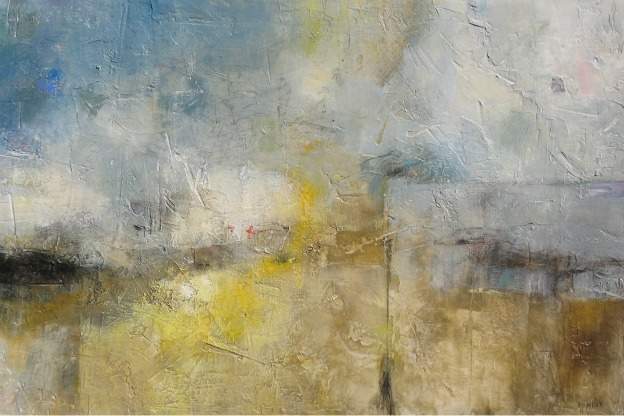
This story was originally published and broadcast October 13, 2011.
Artists Tamar Kander and Jamas Brooke live and work in a log cabin in Brown County. In many ways, the couple's location in this rural spot near the storied artists colony is serendipitous. Having lived all over the world, abstract painter Kander does anything but render the landscape that literally surrounds her studio in the woods. And though Brooke makes traditional pottery, the traditions from which he draws aren't local, but rather Japanese and Native American.
Around The World...
Kander grew up in Israel and Johannesburg, South Africa, where she earned a BFA from the University of the Witwatersrand. She has an MFA with a double major in painting and art therapy from Goldsmith's College, University of London, U.K., and she studied etching and monoprinting at the Art Students' League of New York.
Represented by galleries in Santa Fe, Chicago, Atlanta and Indianapolis, Kander's paintings belong to private and corporate collections around the country and abroad. Yet she manages to keep her home base in Brown County. Kander muses,
There is this idea, that if you're in an environment in which you're comfortable, how can you produce any good work? You've got to be on that cutting edge; you've got to be uncomfortable. For me personally, my art is a refuge, and it doesn't matter where I live, it's not going to reflect the turmoil of the world.
...But Not Of The World
As for the New York-centric contemporary art world? She concedes,
You don't live in a vacuum. I do read; I do go to shows, to museums. You walk the streets and see what's going on. You can't be separate, but I don't feel that I need to be a part of it, necessarily. I do need to be aware of it; it will enrich what I do.
Brooke elaborates. "You can be separate from it, but you still have to, as an artist, participate in it." His large, hand-built ceramic vessels have been shown from Santa Fe to Louisville. "You may choose not to be a part of the achievement-and-success mentality."
The choice to participate in the art world from a distance has had a number of advantages that are a direct function of the couple's location. For starters, there's a small lake down the hill from their house, where both of them swim well into the fall season.
The Accidental Benefits Of Country Living
Beyond its recreational possibilities, the remote spot has offered a professional advantage for the potter. Brooke just built an anagama kiln on his property, and fired it to 1750 degrees Fahrenheit-something he wouldn't have been able to do inside city limits. "But in Brown County all I have to do is call the dispatch," he chuckles, "and they say, 'Ok, you can do it, there's no ban on firing this year.'"
Log cabin life has had its literal advantages for the multi-media painter as well. The previous owners of their house left a tub of the material used for the chinking between the logs-an acrylic compound blended with a coarse dust. "So I had a good time with that!" she recalls.
Kander's additive process begins at the ground level: She roils up a textural surface on the canvas even before painting. In building up the patina of texture and paint that characterizes her canvases, she incorporates flotsam and jetsam with personal significance-a ticket to a performance, a fragment of a card sent by a friend, a sketch or photograph she's made. "The painting just asks for what it needs," she explains.
A Magic Slate
Many of the collaged elements turn out to be fugitive. Over the course of successive layers, she explains, "Sometimes things just have to disappear."
Kander's paintings are palimpsests, like a child's magic slate toy that retains the traces of previous drawings, or a city wall that's been slathered with stucco and paint, posted with bills, sprayed with graffiti, and weathered by the elements over time.
Yet the combination of boldly asserted picture plane with her distinctly urban inspiration somehow yields abstract fields that also evoke deep space and elements of landscape. Some of those elements seem to point more to previous locales than to Kander's current surroundings. She recognizes childhood journeys through the Great Karoo of South Africa and regular trips to the New Mexico desert as references these days.
Memories Of The Desert And The View Of A Pool
The landscape that's surrounded her home studio for the past handful of years seems to have found its way into the work too, however obliquely. A series of small square paintings called Walking After Midnight is informed by moonlit walks on the nearby ridge. It all seems to come back to that feature that brought the couple to Brown County in the first place: "I found that water just crept into all my work," acknowledges Kander, "and this was not something that I planned."
Brooke points out one of the paintings in Kander's studio to show how the water manifests itself: "Even though it's orange-I think this is water. You just have to sit and look at it. You can see leaves floating on the surface of a big pool of water. There's nothing else but the lake."
But Kander's paintings will always elude a literal interpretation. "I wish I still had the piece with a map underneath it, a map of America," Kander remembers. "I was so conscious of how much things change from east to west. But by the time I'd finished, you could maybe see tiny annotations of places. I think only I knew there was a map under there."






